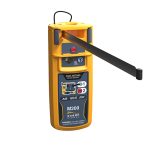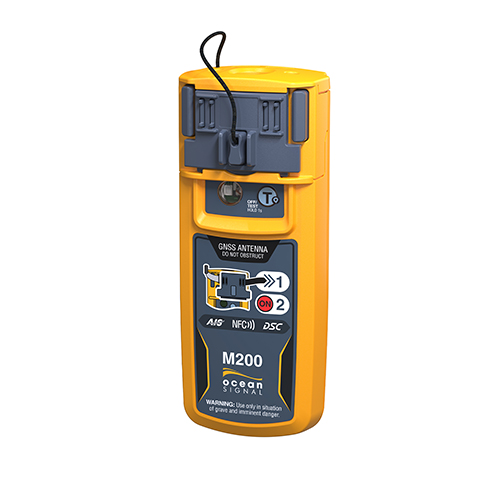AIS (Automatic Identification System)
Integrated VHF DSC transceiver (digital selective calling)*
Class M Compliant (Regulation: ECC/DEC/(22)02)
121.5 MHz Homing Frequency
20% Smaller
Dual strobe lights (White and Infrared)
Fast accurate positioning
Simple Life Jacket integration**
Automatic activation
Want to learn about the latest in Class M Requirements for AIS MOB? Click Here
For U.S. Only: This device has not been authorized as required by the rules of the Federal Communications Commission. This device is not, and may not be, offered for sale or lease, or sold or leased, until authorization is obtained. Approved for sale in countries that have adopted regulation ECC/DEC/(22)02.
Summary
Designed to meet the needs of both recreational boaters and the professional marine market and its offshore workers, the M200 can be fitted to a lifejacket and automatically activates upon inflation of the jacket. Featuring multiple methods of distress alerting, the M200 features dual infrared-white strobe lights and transmits via AIS, DSC, and 121.5 MHz to facilitate rescue efforts and thereby maximize the speed and efficiency of rescue. Compliant with the AIS Class M regulation, the M200 is a Class M DSC (Digital Selective Calling) MOB device that incorporates a durable design with a form factor that is opportunely smaller than other comparable models.
Building upon the tried and proven core architecture of its predecessor, the safeSEA M200 AIS stays true to Ocean Signal’s core design principles and accomplishes an impressive feat by bundling additional features into an even more compact form factor. Meeting regulation ECC/DEC/(22)02, otherwise known as the AIS Class M Regulation, the M200 includes a DSC (Digital Selective Calling) Receiver which is utilized to stop the MOB from continuing to send DSC messages over the DSC channel once a distress signal has been acknowledged. The inclusion of dual infrared-white strobe lights in combination with distress alerting via AIS, DSC, and 121.5 MHz allows for maximum detection by emergency services.
How it works
Upon activation, the safeSEA M200 AIS starts transmitting the 121.5 MHz homing signal and then the first individual distress will be broadcast within 15 seconds. The M200 sends 8 AIS messages per minute and once a GNSS fix has been obtained, each sequence of 8 AIS messages includes GNSS coordinates to alert rescuers of your precise location. The M200 also has the ability to send various types of DSC messages*. The type of DSC message(s) transmitted (Individual Distress Relay Call, Group Call, or All Ships Distress Alert) is dictated by specific regulations by country.
App Connected
With the inclusion of Near Field Communication (NFC) technology, placing your phone near the beacon automatically launches the Ocean Signal Product App, giving you access to a range of usage data. User specific data such as a vessel’s MMSI can be entered into the M200 while also allowing vital information such as battery life and self-test history to be easily displayed. The use of NFC also ensures that the internal battery life is maximized for safety purposes.
Lifejacket Integration
The safeSEA M200 AIS can be activated manually or automatically when installed within an inflatable lifejacket that automatically inflates. Installation is made simple using the included oral inflation tube clip to attach the M200 to the lifejacket in conjunction with the activation tape connected around the bladder of the lifejacket**. Once correctly installed, the action of the lifejacket bladder inflating triggers the deployment of the antenna and activation of the beacon.
* DSC functionality is subject to regulations of country.
** Always refer to the lifejacket manufacturer for specific instructions before installing this product directly to your lifejacket.
Features and Benefits of the Ocean Signal safeSEA M200 AIS:
- AIS (Automatic Identification System)
- Class M Compliant (regulation ECC/DEC/(22)02)
- Integrated Tx and Rx DSC transceiver (Digital Selective Calling) *
- LEDs verify DSC distress signal receipt
- 20% (typ) smaller than competitors
- GNSS via GPS, and Galileo
- Fast accurate positioning
- 121.5 MHz Homing Signal
- IR and White Strobe Lights
- LEDs verify DSC distress signal receipt
- Automatic activation
- Simple lifejacket integration**
- 5-year battery life
- 12+ hours operational life
- 2-year warranty
- Integrated Near Field Communication (NFC)
- Smartphone connectivity via NFC
- Ocean Signal Mobile App (IOS and Android)
Compatibility: Most modern AIS plotters and DSC VHF comply with the standards required to receive MOB transmissions. It is however, especially if you are using older equipment, recommended that you check compatibility with the equipment manufacturer.
Want to learn about the latest in Class M Requirements for AIS MOB? Click Here











